Military Leadership Analysis: Examining General George S. Patton
VerifiedAdded on 2023/06/18
|10
|3690
|161
Essay
AI Summary
This essay provides an analysis of leadership, focusing on the strategies and traits of General George S. Patton. It explores his background, his military achievements, and the various leadership principles he embodied, such as bearing, courage, decisiveness, judgment, justice, tact, and discipline. The essay also discusses Patton's leadership principles, including fostering teamwork, maintaining fitness, and demonstrating boldness and determination. It highlights how these qualities and principles contributed to his success as a military leader and offers insights into effective leadership practices applicable in various contexts. Desklib provides a platform for students to access similar solved assignments and past papers for academic support.
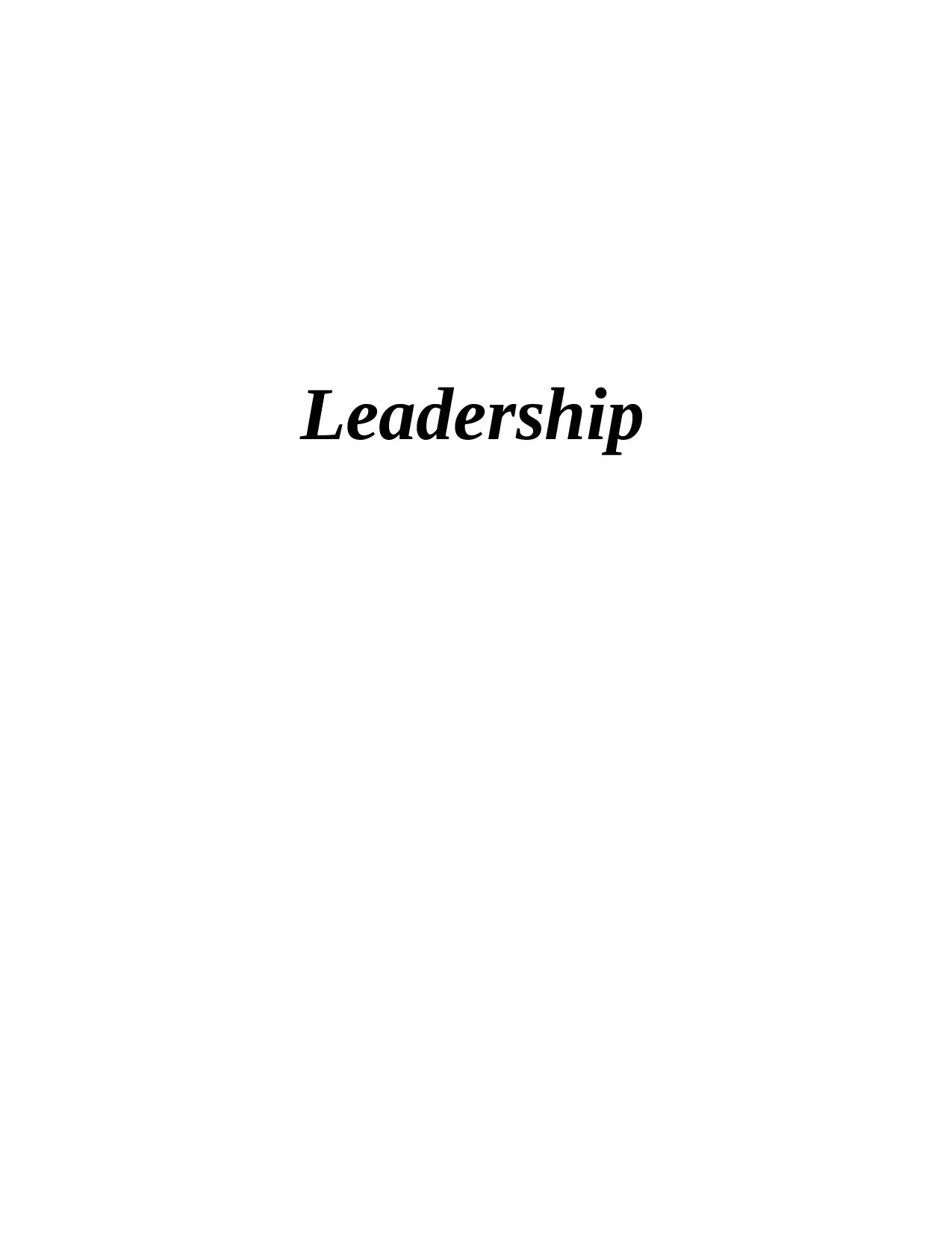
Leadership
Paraphrase This Document
Need a fresh take? Get an instant paraphrase of this document with our AI Paraphraser
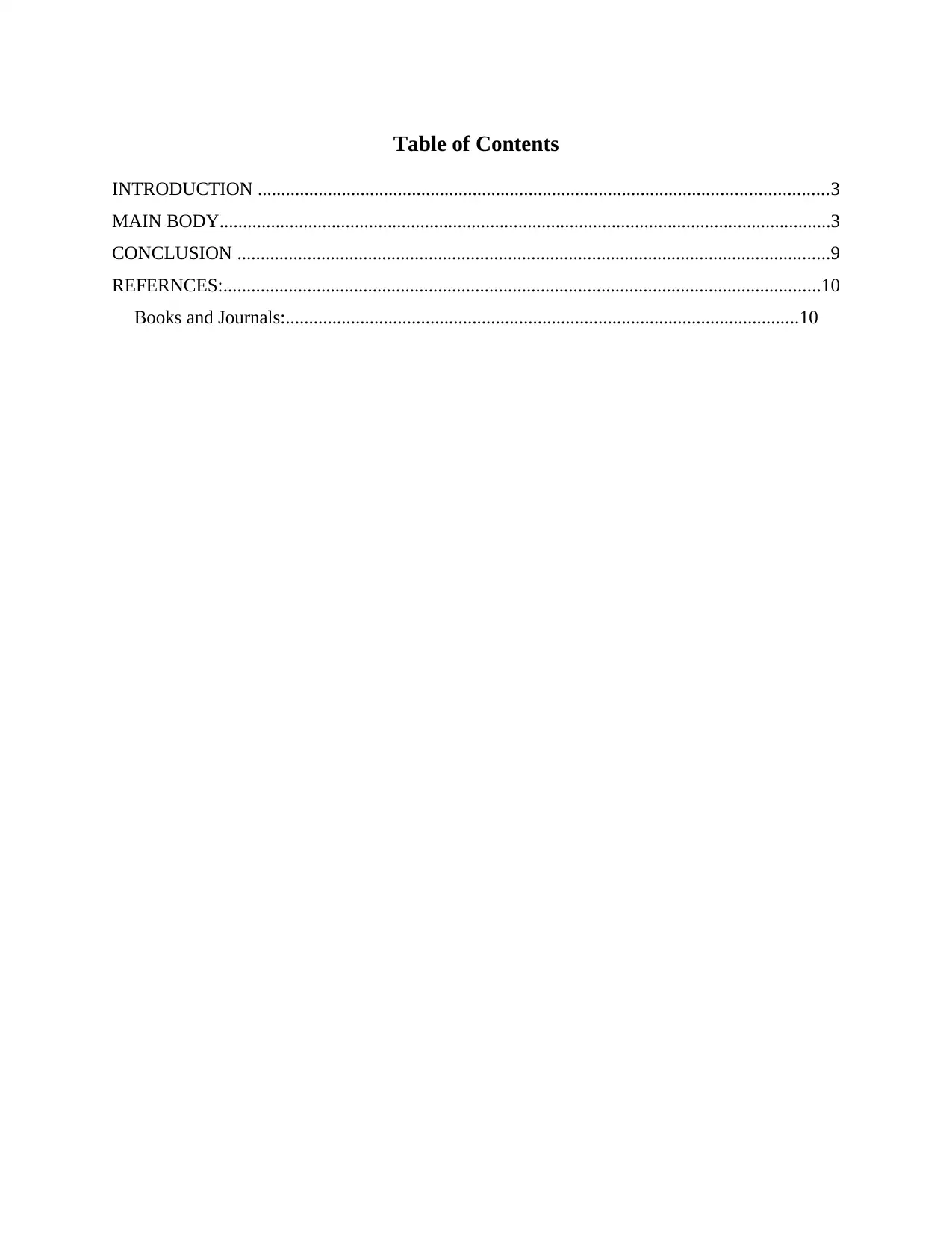
Table of Contents
INTRODUCTION ..........................................................................................................................3
MAIN BODY...................................................................................................................................3
CONCLUSION ...............................................................................................................................9
REFERNCES:................................................................................................................................10
Books and Journals:..............................................................................................................10
INTRODUCTION ..........................................................................................................................3
MAIN BODY...................................................................................................................................3
CONCLUSION ...............................................................................................................................9
REFERNCES:................................................................................................................................10
Books and Journals:..............................................................................................................10
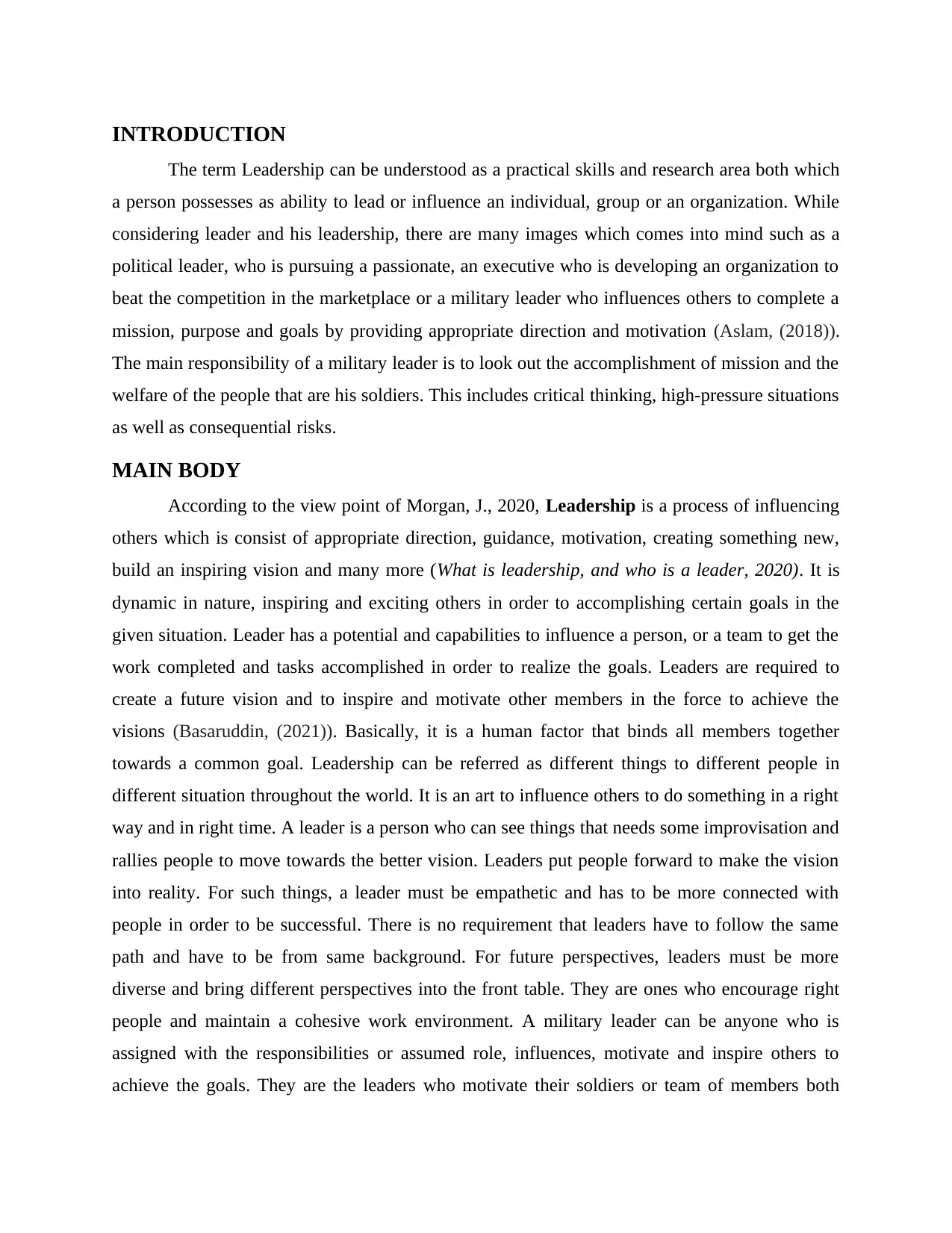
INTRODUCTION
The term Leadership can be understood as a practical skills and research area both which
a person possesses as ability to lead or influence an individual, group or an organization. While
considering leader and his leadership, there are many images which comes into mind such as a
political leader, who is pursuing a passionate, an executive who is developing an organization to
beat the competition in the marketplace or a military leader who influences others to complete a
mission, purpose and goals by providing appropriate direction and motivation (Aslam, (2018)).
The main responsibility of a military leader is to look out the accomplishment of mission and the
welfare of the people that are his soldiers. This includes critical thinking, high-pressure situations
as well as consequential risks.
MAIN BODY
According to the view point of Morgan, J., 2020, Leadership is a process of influencing
others which is consist of appropriate direction, guidance, motivation, creating something new,
build an inspiring vision and many more (What is leadership, and who is a leader, 2020). It is
dynamic in nature, inspiring and exciting others in order to accomplishing certain goals in the
given situation. Leader has a potential and capabilities to influence a person, or a team to get the
work completed and tasks accomplished in order to realize the goals. Leaders are required to
create a future vision and to inspire and motivate other members in the force to achieve the
visions (Basaruddin, (2021)). Basically, it is a human factor that binds all members together
towards a common goal. Leadership can be referred as different things to different people in
different situation throughout the world. It is an art to influence others to do something in a right
way and in right time. A leader is a person who can see things that needs some improvisation and
rallies people to move towards the better vision. Leaders put people forward to make the vision
into reality. For such things, a leader must be empathetic and has to be more connected with
people in order to be successful. There is no requirement that leaders have to follow the same
path and have to be from same background. For future perspectives, leaders must be more
diverse and bring different perspectives into the front table. They are ones who encourage right
people and maintain a cohesive work environment. A military leader can be anyone who is
assigned with the responsibilities or assumed role, influences, motivate and inspire others to
achieve the goals. They are the leaders who motivate their soldiers or team of members both
The term Leadership can be understood as a practical skills and research area both which
a person possesses as ability to lead or influence an individual, group or an organization. While
considering leader and his leadership, there are many images which comes into mind such as a
political leader, who is pursuing a passionate, an executive who is developing an organization to
beat the competition in the marketplace or a military leader who influences others to complete a
mission, purpose and goals by providing appropriate direction and motivation (Aslam, (2018)).
The main responsibility of a military leader is to look out the accomplishment of mission and the
welfare of the people that are his soldiers. This includes critical thinking, high-pressure situations
as well as consequential risks.
MAIN BODY
According to the view point of Morgan, J., 2020, Leadership is a process of influencing
others which is consist of appropriate direction, guidance, motivation, creating something new,
build an inspiring vision and many more (What is leadership, and who is a leader, 2020). It is
dynamic in nature, inspiring and exciting others in order to accomplishing certain goals in the
given situation. Leader has a potential and capabilities to influence a person, or a team to get the
work completed and tasks accomplished in order to realize the goals. Leaders are required to
create a future vision and to inspire and motivate other members in the force to achieve the
visions (Basaruddin, (2021)). Basically, it is a human factor that binds all members together
towards a common goal. Leadership can be referred as different things to different people in
different situation throughout the world. It is an art to influence others to do something in a right
way and in right time. A leader is a person who can see things that needs some improvisation and
rallies people to move towards the better vision. Leaders put people forward to make the vision
into reality. For such things, a leader must be empathetic and has to be more connected with
people in order to be successful. There is no requirement that leaders have to follow the same
path and have to be from same background. For future perspectives, leaders must be more
diverse and bring different perspectives into the front table. They are ones who encourage right
people and maintain a cohesive work environment. A military leader can be anyone who is
assigned with the responsibilities or assumed role, influences, motivate and inspire others to
achieve the goals. They are the leaders who motivate their soldiers or team of members both
⊘ This is a preview!⊘
Do you want full access?
Subscribe today to unlock all pages.

Trusted by 1+ million students worldwide
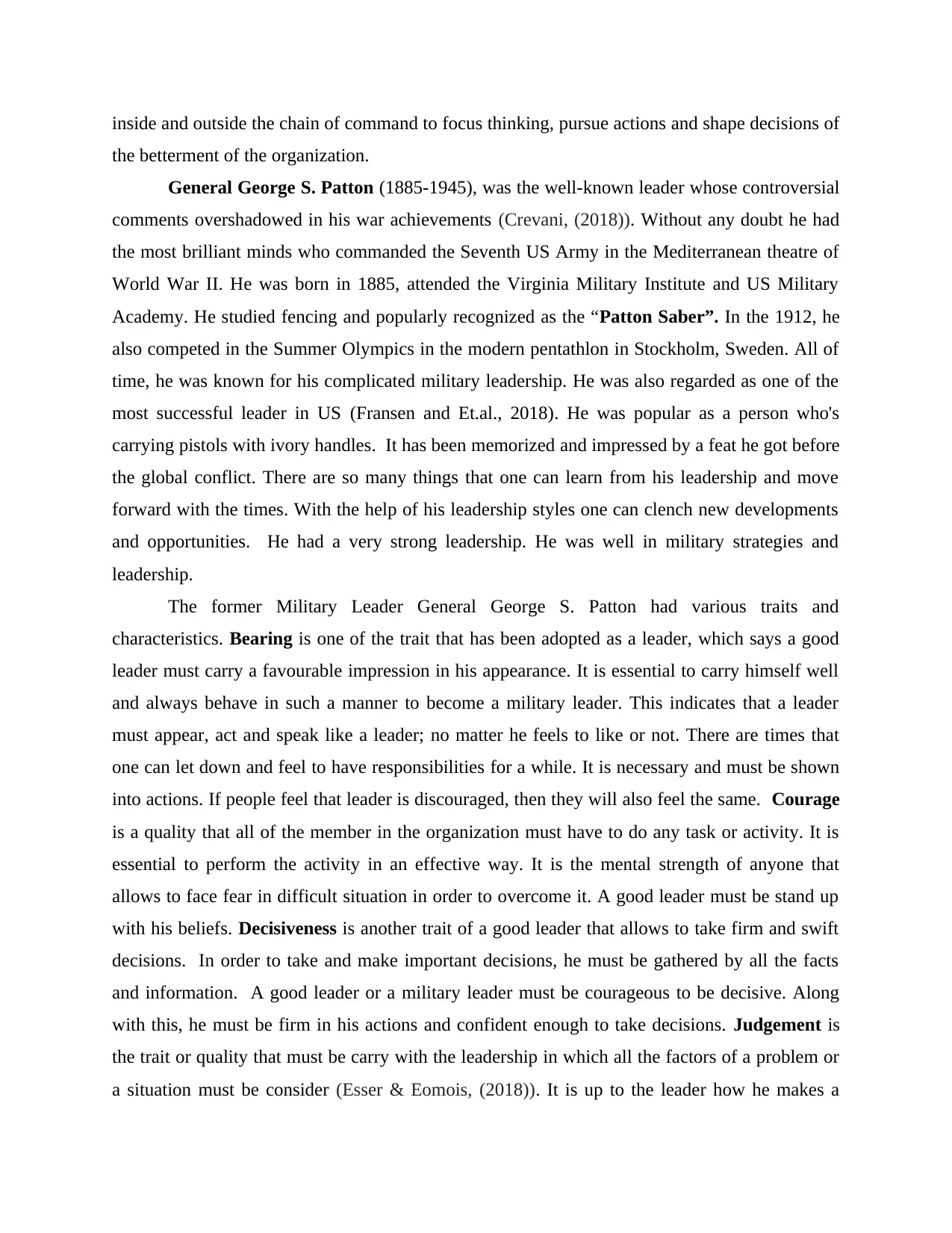
inside and outside the chain of command to focus thinking, pursue actions and shape decisions of
the betterment of the organization.
General George S. Patton (1885-1945), was the well-known leader whose controversial
comments overshadowed in his war achievements (Crevani, (2018)). Without any doubt he had
the most brilliant minds who commanded the Seventh US Army in the Mediterranean theatre of
World War II. He was born in 1885, attended the Virginia Military Institute and US Military
Academy. He studied fencing and popularly recognized as the “Patton Saber”. In the 1912, he
also competed in the Summer Olympics in the modern pentathlon in Stockholm, Sweden. All of
time, he was known for his complicated military leadership. He was also regarded as one of the
most successful leader in US (Fransen and Et.al., 2018). He was popular as a person who's
carrying pistols with ivory handles. It has been memorized and impressed by a feat he got before
the global conflict. There are so many things that one can learn from his leadership and move
forward with the times. With the help of his leadership styles one can clench new developments
and opportunities. He had a very strong leadership. He was well in military strategies and
leadership.
The former Military Leader General George S. Patton had various traits and
characteristics. Bearing is one of the trait that has been adopted as a leader, which says a good
leader must carry a favourable impression in his appearance. It is essential to carry himself well
and always behave in such a manner to become a military leader. This indicates that a leader
must appear, act and speak like a leader; no matter he feels to like or not. There are times that
one can let down and feel to have responsibilities for a while. It is necessary and must be shown
into actions. If people feel that leader is discouraged, then they will also feel the same. Courage
is a quality that all of the member in the organization must have to do any task or activity. It is
essential to perform the activity in an effective way. It is the mental strength of anyone that
allows to face fear in difficult situation in order to overcome it. A good leader must be stand up
with his beliefs. Decisiveness is another trait of a good leader that allows to take firm and swift
decisions. In order to take and make important decisions, he must be gathered by all the facts
and information. A good leader or a military leader must be courageous to be decisive. Along
with this, he must be firm in his actions and confident enough to take decisions. Judgement is
the trait or quality that must be carry with the leadership in which all the factors of a problem or
a situation must be consider (Esser & Eomois, (2018)). It is up to the leader how he makes a
the betterment of the organization.
General George S. Patton (1885-1945), was the well-known leader whose controversial
comments overshadowed in his war achievements (Crevani, (2018)). Without any doubt he had
the most brilliant minds who commanded the Seventh US Army in the Mediterranean theatre of
World War II. He was born in 1885, attended the Virginia Military Institute and US Military
Academy. He studied fencing and popularly recognized as the “Patton Saber”. In the 1912, he
also competed in the Summer Olympics in the modern pentathlon in Stockholm, Sweden. All of
time, he was known for his complicated military leadership. He was also regarded as one of the
most successful leader in US (Fransen and Et.al., 2018). He was popular as a person who's
carrying pistols with ivory handles. It has been memorized and impressed by a feat he got before
the global conflict. There are so many things that one can learn from his leadership and move
forward with the times. With the help of his leadership styles one can clench new developments
and opportunities. He had a very strong leadership. He was well in military strategies and
leadership.
The former Military Leader General George S. Patton had various traits and
characteristics. Bearing is one of the trait that has been adopted as a leader, which says a good
leader must carry a favourable impression in his appearance. It is essential to carry himself well
and always behave in such a manner to become a military leader. This indicates that a leader
must appear, act and speak like a leader; no matter he feels to like or not. There are times that
one can let down and feel to have responsibilities for a while. It is necessary and must be shown
into actions. If people feel that leader is discouraged, then they will also feel the same. Courage
is a quality that all of the member in the organization must have to do any task or activity. It is
essential to perform the activity in an effective way. It is the mental strength of anyone that
allows to face fear in difficult situation in order to overcome it. A good leader must be stand up
with his beliefs. Decisiveness is another trait of a good leader that allows to take firm and swift
decisions. In order to take and make important decisions, he must be gathered by all the facts
and information. A good leader or a military leader must be courageous to be decisive. Along
with this, he must be firm in his actions and confident enough to take decisions. Judgement is
the trait or quality that must be carry with the leadership in which all the factors of a problem or
a situation must be consider (Esser & Eomois, (2018)). It is up to the leader how he makes a
Paraphrase This Document
Need a fresh take? Get an instant paraphrase of this document with our AI Paraphraser
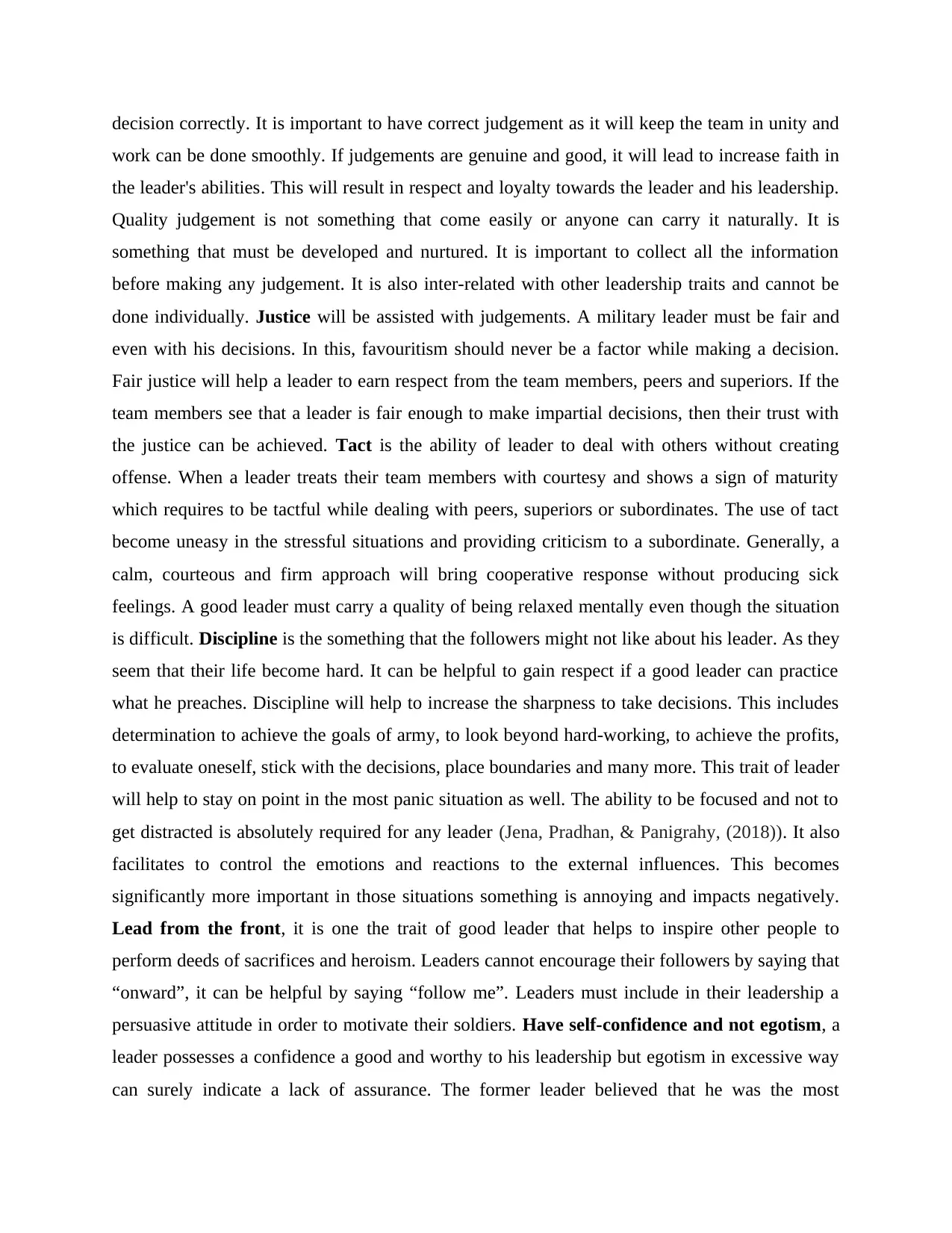
decision correctly. It is important to have correct judgement as it will keep the team in unity and
work can be done smoothly. If judgements are genuine and good, it will lead to increase faith in
the leader's abilities. This will result in respect and loyalty towards the leader and his leadership.
Quality judgement is not something that come easily or anyone can carry it naturally. It is
something that must be developed and nurtured. It is important to collect all the information
before making any judgement. It is also inter-related with other leadership traits and cannot be
done individually. Justice will be assisted with judgements. A military leader must be fair and
even with his decisions. In this, favouritism should never be a factor while making a decision.
Fair justice will help a leader to earn respect from the team members, peers and superiors. If the
team members see that a leader is fair enough to make impartial decisions, then their trust with
the justice can be achieved. Tact is the ability of leader to deal with others without creating
offense. When a leader treats their team members with courtesy and shows a sign of maturity
which requires to be tactful while dealing with peers, superiors or subordinates. The use of tact
become uneasy in the stressful situations and providing criticism to a subordinate. Generally, a
calm, courteous and firm approach will bring cooperative response without producing sick
feelings. A good leader must carry a quality of being relaxed mentally even though the situation
is difficult. Discipline is the something that the followers might not like about his leader. As they
seem that their life become hard. It can be helpful to gain respect if a good leader can practice
what he preaches. Discipline will help to increase the sharpness to take decisions. This includes
determination to achieve the goals of army, to look beyond hard-working, to achieve the profits,
to evaluate oneself, stick with the decisions, place boundaries and many more. This trait of leader
will help to stay on point in the most panic situation as well. The ability to be focused and not to
get distracted is absolutely required for any leader (Jena, Pradhan, & Panigrahy, (2018)). It also
facilitates to control the emotions and reactions to the external influences. This becomes
significantly more important in those situations something is annoying and impacts negatively.
Lead from the front, it is one the trait of good leader that helps to inspire other people to
perform deeds of sacrifices and heroism. Leaders cannot encourage their followers by saying that
“onward”, it can be helpful by saying “follow me”. Leaders must include in their leadership a
persuasive attitude in order to motivate their soldiers. Have self-confidence and not egotism, a
leader possesses a confidence a good and worthy to his leadership but egotism in excessive way
can surely indicate a lack of assurance. The former leader believed that he was the most
work can be done smoothly. If judgements are genuine and good, it will lead to increase faith in
the leader's abilities. This will result in respect and loyalty towards the leader and his leadership.
Quality judgement is not something that come easily or anyone can carry it naturally. It is
something that must be developed and nurtured. It is important to collect all the information
before making any judgement. It is also inter-related with other leadership traits and cannot be
done individually. Justice will be assisted with judgements. A military leader must be fair and
even with his decisions. In this, favouritism should never be a factor while making a decision.
Fair justice will help a leader to earn respect from the team members, peers and superiors. If the
team members see that a leader is fair enough to make impartial decisions, then their trust with
the justice can be achieved. Tact is the ability of leader to deal with others without creating
offense. When a leader treats their team members with courtesy and shows a sign of maturity
which requires to be tactful while dealing with peers, superiors or subordinates. The use of tact
become uneasy in the stressful situations and providing criticism to a subordinate. Generally, a
calm, courteous and firm approach will bring cooperative response without producing sick
feelings. A good leader must carry a quality of being relaxed mentally even though the situation
is difficult. Discipline is the something that the followers might not like about his leader. As they
seem that their life become hard. It can be helpful to gain respect if a good leader can practice
what he preaches. Discipline will help to increase the sharpness to take decisions. This includes
determination to achieve the goals of army, to look beyond hard-working, to achieve the profits,
to evaluate oneself, stick with the decisions, place boundaries and many more. This trait of leader
will help to stay on point in the most panic situation as well. The ability to be focused and not to
get distracted is absolutely required for any leader (Jena, Pradhan, & Panigrahy, (2018)). It also
facilitates to control the emotions and reactions to the external influences. This becomes
significantly more important in those situations something is annoying and impacts negatively.
Lead from the front, it is one the trait of good leader that helps to inspire other people to
perform deeds of sacrifices and heroism. Leaders cannot encourage their followers by saying that
“onward”, it can be helpful by saying “follow me”. Leaders must include in their leadership a
persuasive attitude in order to motivate their soldiers. Have self-confidence and not egotism, a
leader possesses a confidence a good and worthy to his leadership but egotism in excessive way
can surely indicate a lack of assurance. The former leader believed that he was the most
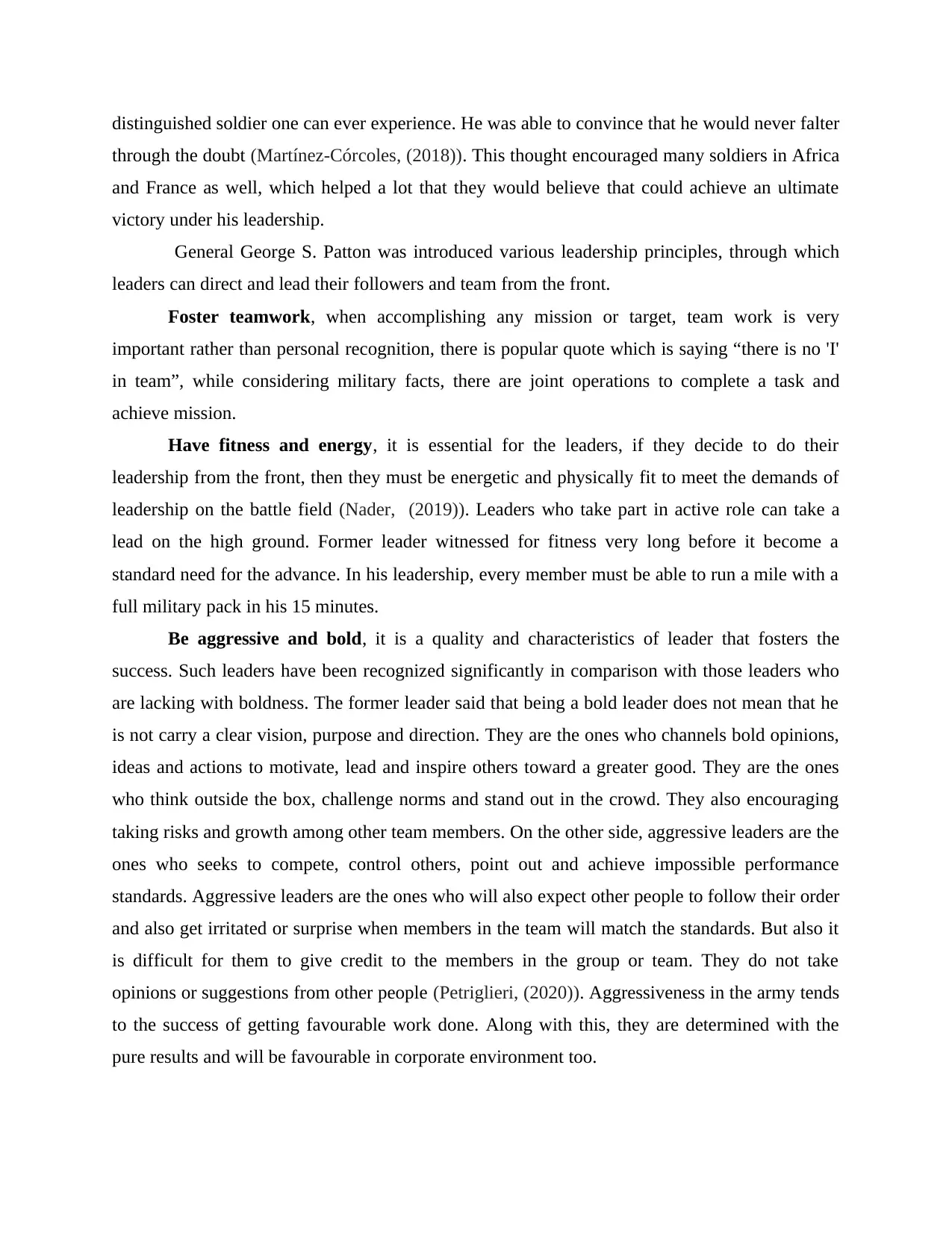
distinguished soldier one can ever experience. He was able to convince that he would never falter
through the doubt (Martínez‐Córcoles, (2018)). This thought encouraged many soldiers in Africa
and France as well, which helped a lot that they would believe that could achieve an ultimate
victory under his leadership.
General George S. Patton was introduced various leadership principles, through which
leaders can direct and lead their followers and team from the front.
Foster teamwork, when accomplishing any mission or target, team work is very
important rather than personal recognition, there is popular quote which is saying “there is no 'I'
in team”, while considering military facts, there are joint operations to complete a task and
achieve mission.
Have fitness and energy, it is essential for the leaders, if they decide to do their
leadership from the front, then they must be energetic and physically fit to meet the demands of
leadership on the battle field (Nader, (2019)). Leaders who take part in active role can take a
lead on the high ground. Former leader witnessed for fitness very long before it become a
standard need for the advance. In his leadership, every member must be able to run a mile with a
full military pack in his 15 minutes.
Be aggressive and bold, it is a quality and characteristics of leader that fosters the
success. Such leaders have been recognized significantly in comparison with those leaders who
are lacking with boldness. The former leader said that being a bold leader does not mean that he
is not carry a clear vision, purpose and direction. They are the ones who channels bold opinions,
ideas and actions to motivate, lead and inspire others toward a greater good. They are the ones
who think outside the box, challenge norms and stand out in the crowd. They also encouraging
taking risks and growth among other team members. On the other side, aggressive leaders are the
ones who seeks to compete, control others, point out and achieve impossible performance
standards. Aggressive leaders are the ones who will also expect other people to follow their order
and also get irritated or surprise when members in the team will match the standards. But also it
is difficult for them to give credit to the members in the group or team. They do not take
opinions or suggestions from other people (Petriglieri, (2020)). Aggressiveness in the army tends
to the success of getting favourable work done. Along with this, they are determined with the
pure results and will be favourable in corporate environment too.
through the doubt (Martínez‐Córcoles, (2018)). This thought encouraged many soldiers in Africa
and France as well, which helped a lot that they would believe that could achieve an ultimate
victory under his leadership.
General George S. Patton was introduced various leadership principles, through which
leaders can direct and lead their followers and team from the front.
Foster teamwork, when accomplishing any mission or target, team work is very
important rather than personal recognition, there is popular quote which is saying “there is no 'I'
in team”, while considering military facts, there are joint operations to complete a task and
achieve mission.
Have fitness and energy, it is essential for the leaders, if they decide to do their
leadership from the front, then they must be energetic and physically fit to meet the demands of
leadership on the battle field (Nader, (2019)). Leaders who take part in active role can take a
lead on the high ground. Former leader witnessed for fitness very long before it become a
standard need for the advance. In his leadership, every member must be able to run a mile with a
full military pack in his 15 minutes.
Be aggressive and bold, it is a quality and characteristics of leader that fosters the
success. Such leaders have been recognized significantly in comparison with those leaders who
are lacking with boldness. The former leader said that being a bold leader does not mean that he
is not carry a clear vision, purpose and direction. They are the ones who channels bold opinions,
ideas and actions to motivate, lead and inspire others toward a greater good. They are the ones
who think outside the box, challenge norms and stand out in the crowd. They also encouraging
taking risks and growth among other team members. On the other side, aggressive leaders are the
ones who seeks to compete, control others, point out and achieve impossible performance
standards. Aggressive leaders are the ones who will also expect other people to follow their order
and also get irritated or surprise when members in the team will match the standards. But also it
is difficult for them to give credit to the members in the group or team. They do not take
opinions or suggestions from other people (Petriglieri, (2020)). Aggressiveness in the army tends
to the success of getting favourable work done. Along with this, they are determined with the
pure results and will be favourable in corporate environment too.
⊘ This is a preview!⊘
Do you want full access?
Subscribe today to unlock all pages.

Trusted by 1+ million students worldwide
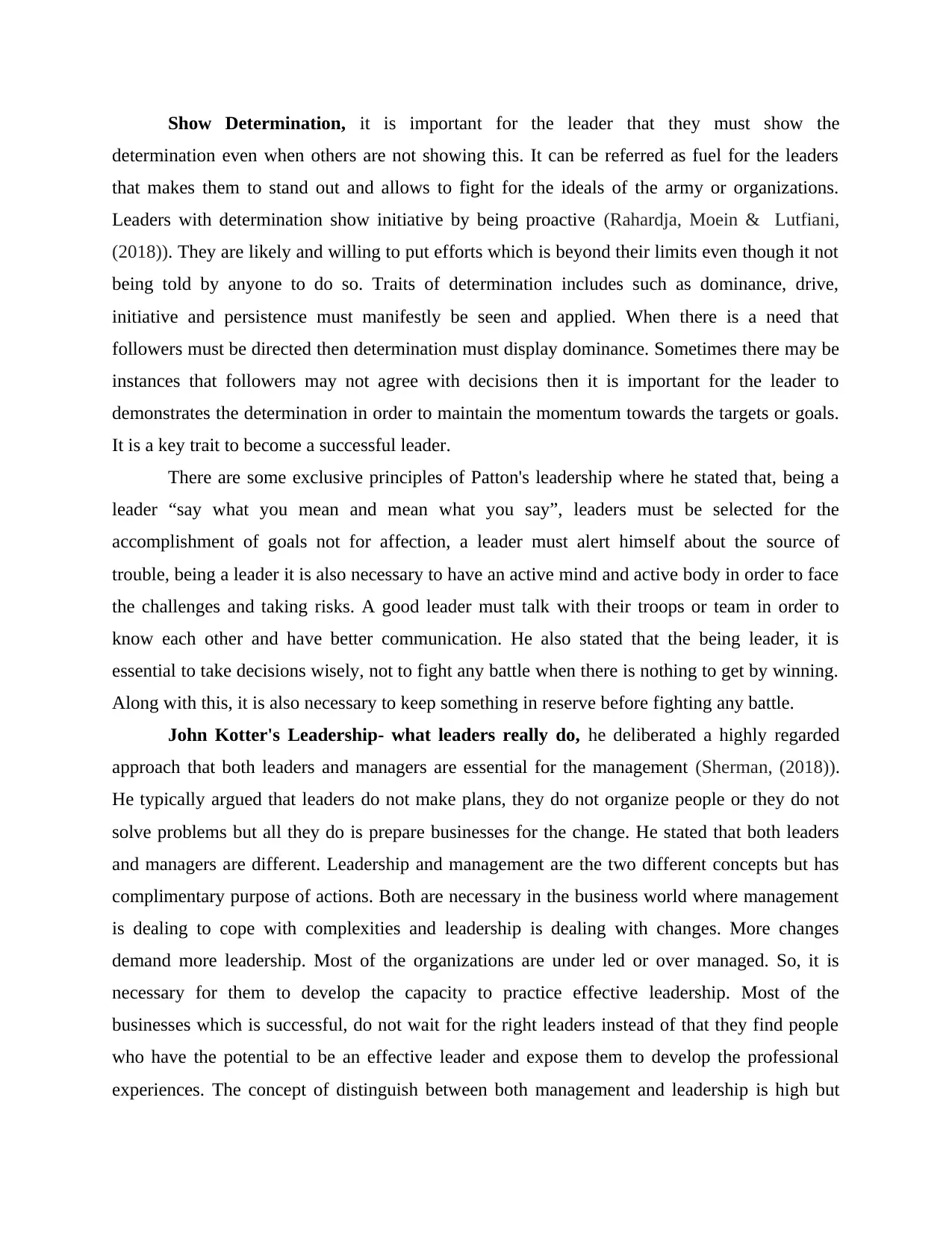
Show Determination, it is important for the leader that they must show the
determination even when others are not showing this. It can be referred as fuel for the leaders
that makes them to stand out and allows to fight for the ideals of the army or organizations.
Leaders with determination show initiative by being proactive (Rahardja, Moein & Lutfiani,
(2018)). They are likely and willing to put efforts which is beyond their limits even though it not
being told by anyone to do so. Traits of determination includes such as dominance, drive,
initiative and persistence must manifestly be seen and applied. When there is a need that
followers must be directed then determination must display dominance. Sometimes there may be
instances that followers may not agree with decisions then it is important for the leader to
demonstrates the determination in order to maintain the momentum towards the targets or goals.
It is a key trait to become a successful leader.
There are some exclusive principles of Patton's leadership where he stated that, being a
leader “say what you mean and mean what you say”, leaders must be selected for the
accomplishment of goals not for affection, a leader must alert himself about the source of
trouble, being a leader it is also necessary to have an active mind and active body in order to face
the challenges and taking risks. A good leader must talk with their troops or team in order to
know each other and have better communication. He also stated that the being leader, it is
essential to take decisions wisely, not to fight any battle when there is nothing to get by winning.
Along with this, it is also necessary to keep something in reserve before fighting any battle.
John Kotter's Leadership- what leaders really do, he deliberated a highly regarded
approach that both leaders and managers are essential for the management (Sherman, (2018)).
He typically argued that leaders do not make plans, they do not organize people or they do not
solve problems but all they do is prepare businesses for the change. He stated that both leaders
and managers are different. Leadership and management are the two different concepts but has
complimentary purpose of actions. Both are necessary in the business world where management
is dealing to cope with complexities and leadership is dealing with changes. More changes
demand more leadership. Most of the organizations are under led or over managed. So, it is
necessary for them to develop the capacity to practice effective leadership. Most of the
businesses which is successful, do not wait for the right leaders instead of that they find people
who have the potential to be an effective leader and expose them to develop the professional
experiences. The concept of distinguish between both management and leadership is high but
determination even when others are not showing this. It can be referred as fuel for the leaders
that makes them to stand out and allows to fight for the ideals of the army or organizations.
Leaders with determination show initiative by being proactive (Rahardja, Moein & Lutfiani,
(2018)). They are likely and willing to put efforts which is beyond their limits even though it not
being told by anyone to do so. Traits of determination includes such as dominance, drive,
initiative and persistence must manifestly be seen and applied. When there is a need that
followers must be directed then determination must display dominance. Sometimes there may be
instances that followers may not agree with decisions then it is important for the leader to
demonstrates the determination in order to maintain the momentum towards the targets or goals.
It is a key trait to become a successful leader.
There are some exclusive principles of Patton's leadership where he stated that, being a
leader “say what you mean and mean what you say”, leaders must be selected for the
accomplishment of goals not for affection, a leader must alert himself about the source of
trouble, being a leader it is also necessary to have an active mind and active body in order to face
the challenges and taking risks. A good leader must talk with their troops or team in order to
know each other and have better communication. He also stated that the being leader, it is
essential to take decisions wisely, not to fight any battle when there is nothing to get by winning.
Along with this, it is also necessary to keep something in reserve before fighting any battle.
John Kotter's Leadership- what leaders really do, he deliberated a highly regarded
approach that both leaders and managers are essential for the management (Sherman, (2018)).
He typically argued that leaders do not make plans, they do not organize people or they do not
solve problems but all they do is prepare businesses for the change. He stated that both leaders
and managers are different. Leadership and management are the two different concepts but has
complimentary purpose of actions. Both are necessary in the business world where management
is dealing to cope with complexities and leadership is dealing with changes. More changes
demand more leadership. Most of the organizations are under led or over managed. So, it is
necessary for them to develop the capacity to practice effective leadership. Most of the
businesses which is successful, do not wait for the right leaders instead of that they find people
who have the potential to be an effective leader and expose them to develop the professional
experiences. The concept of distinguish between both management and leadership is high but
Paraphrase This Document
Need a fresh take? Get an instant paraphrase of this document with our AI Paraphraser

they both are essential for the organizations. Management involves planning and budgeting, on
the other side leadership is done with setting guidance and direction. The purpose of
management is to predict but the function of leadership is to create and produce the change.
There is nothing mysterious about this but is more inductive than planning and budgeting which
involves search of patterns and their relationships with them. Management also provides control
and tend to solve problems, whereas leadership provides motivation to the team. Management
enables members to compete their given tasks and jobs day by day whereas leaders try to attempt
their people at deepest levels in order to motivate them (John Kotter on Leadership, 2021).
Daniel Goleman- leadership that gets results, it has been argued that single job of
leader is to get results only. Most of the managers assumed that the leader's job is to perform the
function of personality only rather than to make the strategic choices (Waterman & Wright,
(2018)). It has been found through various research is that leaders have the strength in the
mentioned emotional intelligence competencies; self-regulation, self-awareness, empathy,
motivation or social skills. There are different leadership styles which makes use of the
emotional intelligence competencies in different combination.
The democratic style is type of leadership style in which leader allowed his team
members to take participation in the decision making process. In this style, everyone is given
with opportunities to speak up freely, where discussion is encouraged. Team members feel more
encouraged in the process. Along with this, research has been shown that democratic leaders
possess special qualities such as courage, honesty, intelligence, fairness, creativity and many
more.
The authoritative style can be taken as a management approach where one person has a
total control to make decisions and regulate processes, where input of the team members is very
little or no participation. Leaders independently preside policies, procedures and processes. It can
be advantageous in organizations and industry where decisions need to be make in hurry or very
urgently. It is also critical that certain activities must be performed in certain way as there is no
space for mistakes in those situations. In this style of leadership, leaders are the most
knowledgeable person in the business.
I learned and developed a lot of things from the above description of leadership. I
realized that leadership is very important in the business and every aspect of life. To be a leader
of any organization, it is essential to have clear vision, purpose and clarity of thoughts in order to
the other side leadership is done with setting guidance and direction. The purpose of
management is to predict but the function of leadership is to create and produce the change.
There is nothing mysterious about this but is more inductive than planning and budgeting which
involves search of patterns and their relationships with them. Management also provides control
and tend to solve problems, whereas leadership provides motivation to the team. Management
enables members to compete their given tasks and jobs day by day whereas leaders try to attempt
their people at deepest levels in order to motivate them (John Kotter on Leadership, 2021).
Daniel Goleman- leadership that gets results, it has been argued that single job of
leader is to get results only. Most of the managers assumed that the leader's job is to perform the
function of personality only rather than to make the strategic choices (Waterman & Wright,
(2018)). It has been found through various research is that leaders have the strength in the
mentioned emotional intelligence competencies; self-regulation, self-awareness, empathy,
motivation or social skills. There are different leadership styles which makes use of the
emotional intelligence competencies in different combination.
The democratic style is type of leadership style in which leader allowed his team
members to take participation in the decision making process. In this style, everyone is given
with opportunities to speak up freely, where discussion is encouraged. Team members feel more
encouraged in the process. Along with this, research has been shown that democratic leaders
possess special qualities such as courage, honesty, intelligence, fairness, creativity and many
more.
The authoritative style can be taken as a management approach where one person has a
total control to make decisions and regulate processes, where input of the team members is very
little or no participation. Leaders independently preside policies, procedures and processes. It can
be advantageous in organizations and industry where decisions need to be make in hurry or very
urgently. It is also critical that certain activities must be performed in certain way as there is no
space for mistakes in those situations. In this style of leadership, leaders are the most
knowledgeable person in the business.
I learned and developed a lot of things from the above description of leadership. I
realized that leadership is very important in the business and every aspect of life. To be a leader
of any organization, it is essential to have clear vision, purpose and clarity of thoughts in order to
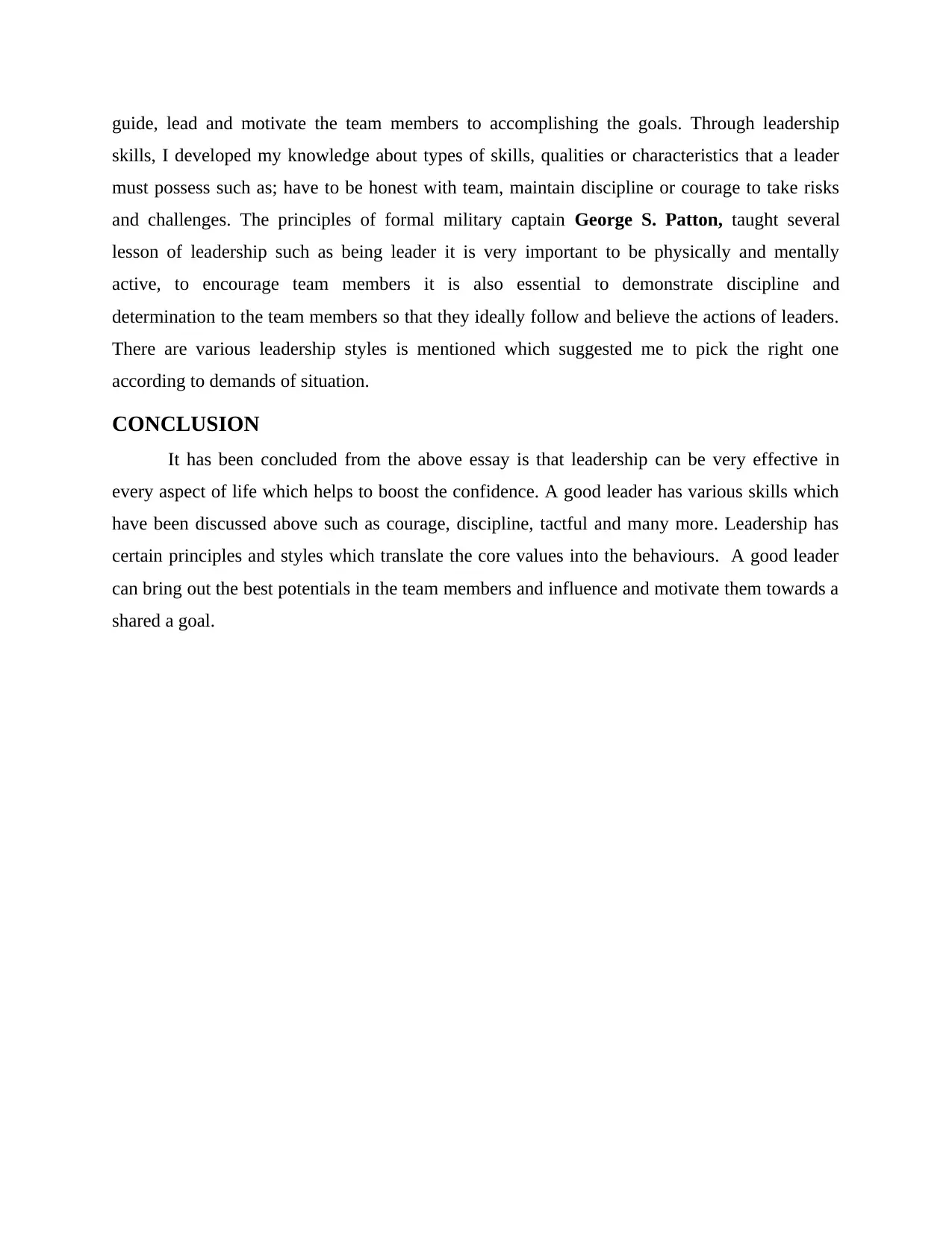
guide, lead and motivate the team members to accomplishing the goals. Through leadership
skills, I developed my knowledge about types of skills, qualities or characteristics that a leader
must possess such as; have to be honest with team, maintain discipline or courage to take risks
and challenges. The principles of formal military captain George S. Patton, taught several
lesson of leadership such as being leader it is very important to be physically and mentally
active, to encourage team members it is also essential to demonstrate discipline and
determination to the team members so that they ideally follow and believe the actions of leaders.
There are various leadership styles is mentioned which suggested me to pick the right one
according to demands of situation.
CONCLUSION
It has been concluded from the above essay is that leadership can be very effective in
every aspect of life which helps to boost the confidence. A good leader has various skills which
have been discussed above such as courage, discipline, tactful and many more. Leadership has
certain principles and styles which translate the core values into the behaviours. A good leader
can bring out the best potentials in the team members and influence and motivate them towards a
shared a goal.
skills, I developed my knowledge about types of skills, qualities or characteristics that a leader
must possess such as; have to be honest with team, maintain discipline or courage to take risks
and challenges. The principles of formal military captain George S. Patton, taught several
lesson of leadership such as being leader it is very important to be physically and mentally
active, to encourage team members it is also essential to demonstrate discipline and
determination to the team members so that they ideally follow and believe the actions of leaders.
There are various leadership styles is mentioned which suggested me to pick the right one
according to demands of situation.
CONCLUSION
It has been concluded from the above essay is that leadership can be very effective in
every aspect of life which helps to boost the confidence. A good leader has various skills which
have been discussed above such as courage, discipline, tactful and many more. Leadership has
certain principles and styles which translate the core values into the behaviours. A good leader
can bring out the best potentials in the team members and influence and motivate them towards a
shared a goal.
⊘ This is a preview!⊘
Do you want full access?
Subscribe today to unlock all pages.

Trusted by 1+ million students worldwide
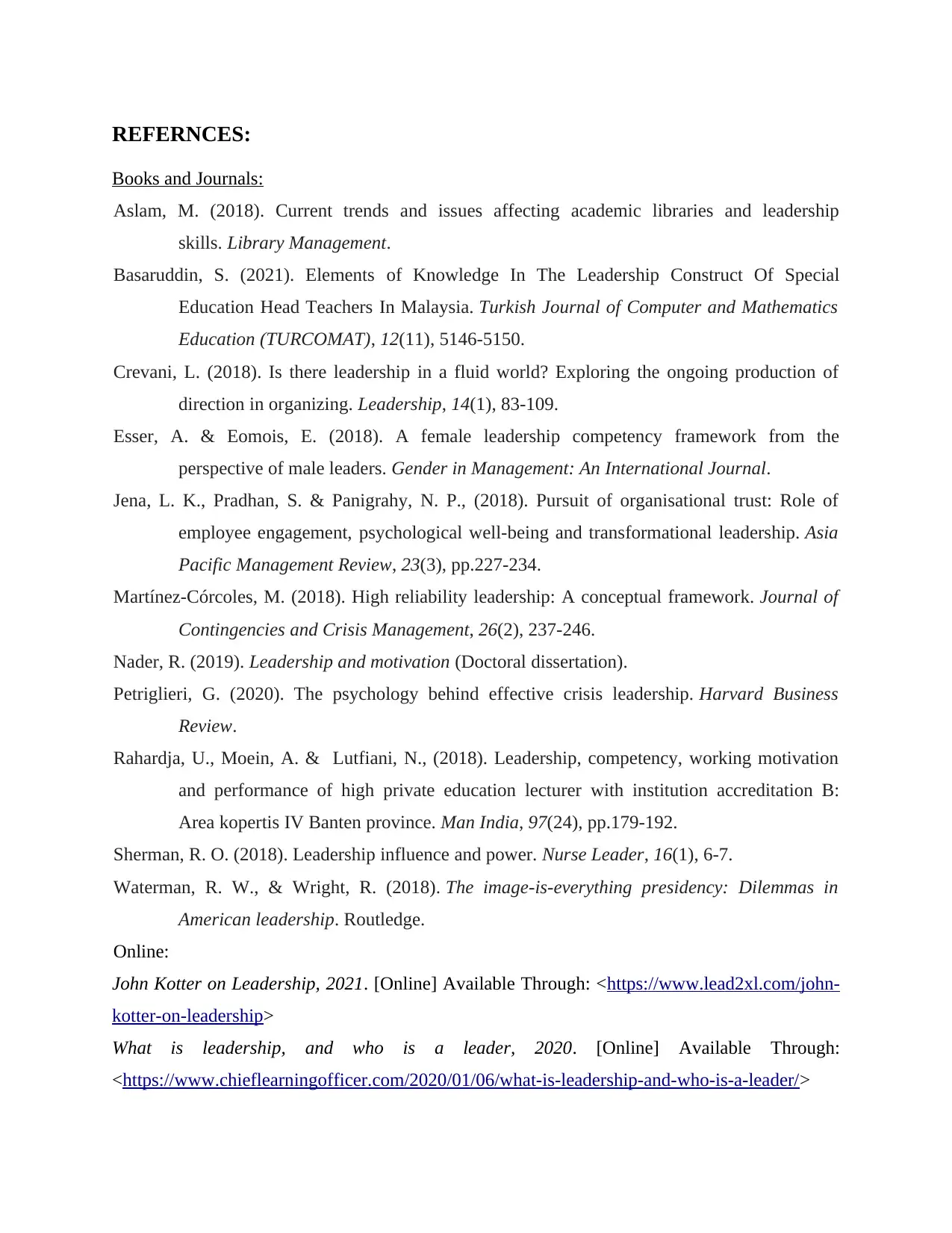
REFERNCES:
Books and Journals:
Aslam, M. (2018). Current trends and issues affecting academic libraries and leadership
skills. Library Management.
Basaruddin, S. (2021). Elements of Knowledge In The Leadership Construct Of Special
Education Head Teachers In Malaysia. Turkish Journal of Computer and Mathematics
Education (TURCOMAT), 12(11), 5146-5150.
Crevani, L. (2018). Is there leadership in a fluid world? Exploring the ongoing production of
direction in organizing. Leadership, 14(1), 83-109.
Esser, A. & Eomois, E. (2018). A female leadership competency framework from the
perspective of male leaders. Gender in Management: An International Journal.
Jena, L. K., Pradhan, S. & Panigrahy, N. P., (2018). Pursuit of organisational trust: Role of
employee engagement, psychological well-being and transformational leadership. Asia
Pacific Management Review, 23(3), pp.227-234.
Martínez‐Córcoles, M. (2018). High reliability leadership: A conceptual framework. Journal of
Contingencies and Crisis Management, 26(2), 237-246.
Nader, R. (2019). Leadership and motivation (Doctoral dissertation).
Petriglieri, G. (2020). The psychology behind effective crisis leadership. Harvard Business
Review.
Rahardja, U., Moein, A. & Lutfiani, N., (2018). Leadership, competency, working motivation
and performance of high private education lecturer with institution accreditation B:
Area kopertis IV Banten province. Man India, 97(24), pp.179-192.
Sherman, R. O. (2018). Leadership influence and power. Nurse Leader, 16(1), 6-7.
Waterman, R. W., & Wright, R. (2018). The image-is-everything presidency: Dilemmas in
American leadership. Routledge.
Online:
John Kotter on Leadership, 2021. [Online] Available Through: <https://www.lead2xl.com/john-
kotter-on-leadership>
What is leadership, and who is a leader, 2020. [Online] Available Through:
<https://www.chieflearningofficer.com/2020/01/06/what-is-leadership-and-who-is-a-leader/>
Books and Journals:
Aslam, M. (2018). Current trends and issues affecting academic libraries and leadership
skills. Library Management.
Basaruddin, S. (2021). Elements of Knowledge In The Leadership Construct Of Special
Education Head Teachers In Malaysia. Turkish Journal of Computer and Mathematics
Education (TURCOMAT), 12(11), 5146-5150.
Crevani, L. (2018). Is there leadership in a fluid world? Exploring the ongoing production of
direction in organizing. Leadership, 14(1), 83-109.
Esser, A. & Eomois, E. (2018). A female leadership competency framework from the
perspective of male leaders. Gender in Management: An International Journal.
Jena, L. K., Pradhan, S. & Panigrahy, N. P., (2018). Pursuit of organisational trust: Role of
employee engagement, psychological well-being and transformational leadership. Asia
Pacific Management Review, 23(3), pp.227-234.
Martínez‐Córcoles, M. (2018). High reliability leadership: A conceptual framework. Journal of
Contingencies and Crisis Management, 26(2), 237-246.
Nader, R. (2019). Leadership and motivation (Doctoral dissertation).
Petriglieri, G. (2020). The psychology behind effective crisis leadership. Harvard Business
Review.
Rahardja, U., Moein, A. & Lutfiani, N., (2018). Leadership, competency, working motivation
and performance of high private education lecturer with institution accreditation B:
Area kopertis IV Banten province. Man India, 97(24), pp.179-192.
Sherman, R. O. (2018). Leadership influence and power. Nurse Leader, 16(1), 6-7.
Waterman, R. W., & Wright, R. (2018). The image-is-everything presidency: Dilemmas in
American leadership. Routledge.
Online:
John Kotter on Leadership, 2021. [Online] Available Through: <https://www.lead2xl.com/john-
kotter-on-leadership>
What is leadership, and who is a leader, 2020. [Online] Available Through:
<https://www.chieflearningofficer.com/2020/01/06/what-is-leadership-and-who-is-a-leader/>
1 out of 10
Related Documents
Your All-in-One AI-Powered Toolkit for Academic Success.
+13062052269
info@desklib.com
Available 24*7 on WhatsApp / Email
![[object Object]](/_next/static/media/star-bottom.7253800d.svg)
Unlock your academic potential
Copyright © 2020–2025 A2Z Services. All Rights Reserved. Developed and managed by ZUCOL.





